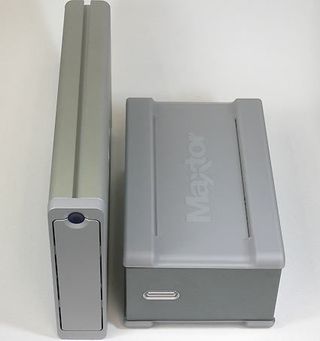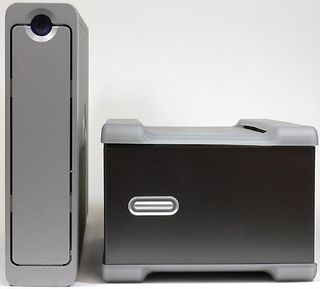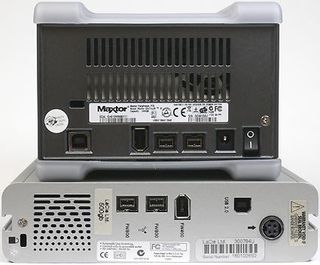The TeraByte Drives Redefine External Storage
LaCie Vs. Maxtor

Both teraByte boxes are massive, but well finished. Maxtor decided to use a plastic case with rubber top and bottom covers, a sufficient number of vents and a small fan at the rear side. Despite the plastic cover, it is slightly heavier, at almost 6 lbs, than LaCie's product (5.6 lbs). The LaCie drive is made of aluminum, and also uses a fan to keep the drives cool. It's good that both fans work at a low speed, so they do not create too much noise. Yet you will hear both unless your computer makes a lot of noise by itself.
Technically, both companies have made products that are pretty much the same. Each consists of a pair of 3.5" hard drives whose capacities are combined in order to hit the fancy capacity point of one million megaBytes (a thousand gigabytes or one teraByte). However, as is always the case with hard drives, these numbers are based on the assumption that a kiloByte consists of 1,000 Bytes, while in fact one kiloByte is 1,024 Bytes. If you go ahead and do the math based on this, both drives actually store approximately 931 GB only.
While LaCie uses Seagate hard drives, Maxtor obviously goes for its own products (although Maxtor has recently been bought by Seagate). The LaCie uses the UltraATA interface, while Maxtor's OneTouch III Turbo is the first external hard drive in our test labs that is based on Serial ATA.
In terms of configuration, Maxtor decided to place one drive on top of the other, giving the OneTouch III Turbo the appearance of a brick; LaCie's Big Disk Extreme looks more like a "storage flounder". Thanks to the active ventilation, both can be stacked without risking any drives overheating. The OneTouch III Turbo can be operated horizontally or vertically, while you will need to mount a stand on the Big Disk Extreme in order to mount it upright.


Stay on the Cutting Edge
Join the experts who read Tom's Hardware for the inside track on enthusiast PC tech news — and have for over 25 years. We'll send breaking news and in-depth reviews of CPUs, GPUs, AI, maker hardware and more straight to your inbox.
Current page: LaCie Vs. Maxtor
Prev Page TeraByte Storage Is Here Next Page LaCie Big Disk Extreme 1 TBMost Popular

